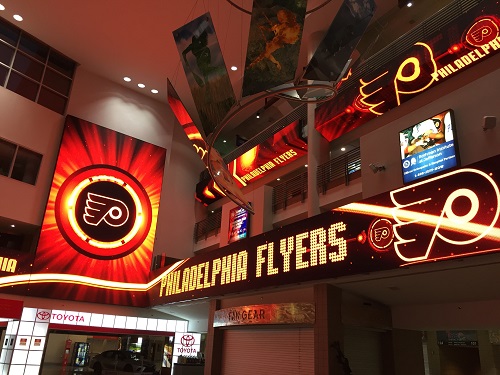Action Busts Through the Bowl at the Wells Fargo Center
Posted on Dec 21, 2017
By Kirsten Nelson, Special to AVIXAThe Wells Fargo Center in Philadelphia has continuously stretched the bounds of large-scale video display throughout its 15-year partnership with integration and content specialist ANC. Together they pioneered one of the earliest 360-degree wraparound LED ribbons in the bowl and went big with an upgraded center-hung display back in 2006, and then moved outdoors to add two massive outdoor displays and highway-facing billboards. Lit with content created and managed by a collaborative in-house and ANC team, the integrated display system sends a cohesive message inside and out with video, animations, sponsor content, promotions, and statistics.
 The relationship is a tight-knit one, and it’s fostered by the Wells Fargo Center’s creative team and a media-savvy client ownership group in Comcast-Spectacor. So, it was only natural that when venue management began its latest upgrade process two years ago, they saw an opportunity for even more large-scale video in the space. Having video-bedazzled so many surfaces already, this time it looked in a totally new direction — the concourses. Not just any concourses, but the two towering atriums that wrap around the height of the bowl inside the Broad Street and 11th Street entrances. There was a lot of blank space in those areas, and more intriguing was the amount of static signage that could be replaced with sparkling new digital options.
The relationship is a tight-knit one, and it’s fostered by the Wells Fargo Center’s creative team and a media-savvy client ownership group in Comcast-Spectacor. So, it was only natural that when venue management began its latest upgrade process two years ago, they saw an opportunity for even more large-scale video in the space. Having video-bedazzled so many surfaces already, this time it looked in a totally new direction — the concourses. Not just any concourses, but the two towering atriums that wrap around the height of the bowl inside the Broad Street and 11th Street entrances. There was a lot of blank space in those areas, and more intriguing was the amount of static signage that could be replaced with sparkling new digital options. The brief was to revolutionize the concourse experience, and to do that, ANC analyzed and maximized each angle of a tremendous blank canvas and illuminated it with 10,500 square feet of LED video walls. Installed in time for the fall 2017 season, the new atrium arrays bring the gigantic scale of in-bowl video boards to the very human level of visitors entering the venue for its 400-plus sporting and entertainment events annually, immersing them in content from the doorway up through four levels of open concourse wall space.
“The effect is analogous to being inside an aquarium, with a flow of content all around you,” said Joshua Keeler, Creative Director for ANC. “There are some venues that have some concourse boards in them, but none to the extent of these two atriums, where there’s massive amounts of square footage of communication potential.”
Designing such a spectacle not just for largess but also for optimum attention-holding immersion, was a process that began from the human perspective. Working from the arena’s original blueprints, ANC’s team of designers created an interactive 3D rendering of the entire arena, enabling a fly-through that would depict how it would feel to move around the newly enlivened atriums.
Using this tool, Keeler said, the team was able to work with the client “to not only design a maximal space for advertising, but also combine it into a seamless experience. We wanted to provide the ability to have the same or similar content on all screens, all perfectly synchronized, so instead of feeling like several different screens each with some distractingly different thing going on, it was more like a single screen that happened to be composed of a bunch of little windows onto a bigger world.”
Arriving at a design scheme that placed one large focal board amid several supporting fascia displays and double-sided video banners in both atriums, ANC selected Mitsubishi XL Series 10mm LED displays for the project. The completed installation placed 26 new surfaces at the fingertips of content creators, the arena’s tenant teams, and sponsors.
The display configuration was unprecedented, so ANC worked with the Wells Fargo Center creative team to develop a template for managing output to all the displays. To present the best possible canvas, with a realistic flow of content across the many surfaces separated by different concourse levels, ANC measured the distance between the physical boards and then timed the video flow accordingly in the template. “Little tweaks like that are what make a multi-board experience so effective,” Keeler said. “If we have snowflakes start on one board and fall down to the next, they’re not going to instantly pop between the boards. It will take time for them to go the 10 feet between them.”
Timing is indeed everything with any display configuration, and the creative team at Wells Fargo Center is pretty well versed in moving video among the many levels of displays in the bowl. But the atrium display arrays are providing some interesting new options for content design. “It’s a whole new way of thinking,” noted Matthew Coppola, Senior Director of Event and Video Production for Comcast Spectacor. “We’re the first arena in the country to be this aggressive with an inside LED system. That presents new opportunities, creative and otherwise, for communicating a message. And the fans love them too. The impact is clear, this changes the entire environment in the building.”
Outfitting the highest-trafficked areas of the venue with floor-to-ceiling video creates two new entertainment zones that can be used for mini events within the main event. It also adds a new option for “moments of exclusivity” sales. From an operations standpoint, this is an easy upgrade. The concourse video displays are controlled through the same system as the signage within the bowl, enabling the venue to seamlessly become an immersive experience with the click of a button.
“That is the art of using ANC’s vSOFT in that venue,” said Melissa Goncalves, Director of Client Services for ANC. “Just having that one-click ability — and then every single board is running the same exact clip at the same time — that synchronicity is huge. It helps the content we’re building in the venue to really resonate.”
Anticipating how viewers will perceive a message as they glance from display to display is an art form that will continue to develop with use of the atrium setup. Meanwhile, getting started with a baseline of new team and sponsor content before the NBA’s Philadelphia 76ers and NHL’s Philadelphia Flyers season openers this year presented some additional challenges. Not only were the new atrium configurations going live, but ANC also installed two new 16mm fascia ribbon LED boards in the bowl, requiring resolutions updates for all existing animations.
The changes were complete just in time, but the process can be time consuming, as every piece is custom made. To manage such bulk changes, ANC has implemented quality control processes that help to streamline its work across many venues all year. Having ANC’s own on-site operators helps, too. When changes are made and new files approved, venue personnel can download the content and add it to live inventory in very efficient fashion.
Response to the new atrium displays has been positive from all angles of immersion. The fans love their effect, sponsors are happy, and the numbers are looking good, too. In the first quarter of use, the Wells Fargo Center advertising sales team has seen 152-percent revenue growth related specifically to the newly LED-enhanced atrium areas.
Needless to say, it was a sound business decision. But the effect is still very human. “It’s truly immersive; it effects your state of being,” Coppola said. “These displays are so bright and beautiful and the art the creative team puts on them is so dynamic. Working with the teams and the sponsors, our goal is to create a seamless experience. So, when fans walk into the building, their experience is stellar and things are as top-notch as they expected.”






